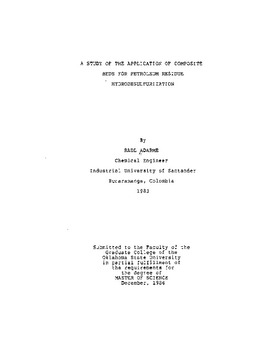| dc.contributor.advisor | Crynes, Billy L. | |
| dc.contributor.author | Adarme, Raul | |
| dc.date.accessioned | 2015-08-20T16:07:02Z | |
| dc.date.available | 2015-08-20T16:07:02Z | |
| dc.date.issued | 1986-12-01 | |
| dc.identifier.uri | https://hdl.handle.net/11244/15764 | |
| dc.description.abstract | The purpose of this study was to investigate the possible advantages of using catalyst activity zoning during hydrodesulfurization of a petroleum residue. Three different commercial Ni-Mo catalysts were employed singly or in combination in a two-zone, trickle bed reactor. The operating conditions were 10.3 MPa, 380�C, 1.0 LHSV (based on total bed volume of both zones), and 1,781 std m3 (hydrogen)/m 3 (oil). | |
| dc.format | application/pdf | |
| dc.language | en_US | |
| dc.publisher | Oklahoma State University | |
| dc.rights | Copyright is held by the author who has granted the Oklahoma State University Library the non-exclusive right to share this material in its institutional repository. Contact Digital Library Services at lib-dls@okstate.edu or 405-744-9161 for the permission policy on the use, reproduction or distribution of this material. | |
| dc.title | Study of the Application of Composite Beds for Petroleum Residue Hydrodesulfurization | |
| dc.type | text | |
| dc.contributor.committeeMember | Seapan, Mayis | |
| dc.contributor.committeeMember | Foutch, Gary Lynn | |
| osu.filename | Thesis-1986-A221s.pdf | |
| osu.accesstype | Open Access | |
| dc.description.department | Chemical Engineering | |
| dc.type.genre | Thesis | |
